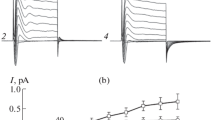Summary
Measurements of chloride flux ratios across frog skin at different clamping voltages showed that chloride transport at clamping voltages from 0 mV to and beyond the spontaneous potential is probably electrodiffusion. At reversed potentials a significant fraction of chloride transport could be described formally as exchange diffusion. Chloride conductance was found to be highly voltage dependent, being largest at hyperpolarizing clamping voltages. The transition from the less conducting state to the more conducting one was studied by recording the time course of the current after a step change in clamping voltage from 0 mV to hyperpolarizing voltages. The shape of the curve is sigmoidal, and the relative rate of change of current increases with increasing hyperpolarization. It is proposed that the change in conductance is governed by the same mechanism as in the toad skin, namely a change in chloride permeability due to voltage gating of chloride channels. The time course of transepithelial conductance after addition of amiloride to the outside solution indicates that a fraction of the decrease in conductance is due to closure of chloride channels caused by the change in intracellular potential due to the inhibition of the sodium channels.
Similar content being viewed by others
References
Biber, T.U.L., Walker, T.C., Mullen, T.L. 1980: Influence of extracellular Cl concentration on chloride transport across isolated skin ofRana pipiens.J. Membrane Biol. 56:81–92
Bruus, K., Kristensen, P., Larsen, E.H. 1976. Pathways for chloride and sodium transport across toad skin.Acta Physiol. Scand. 97:31–47
Candia, O.A. 1978. Reduction of chloride fluxes by amiloride across the short-circuited frog skin.Am. J. Physiol. 234:F437-F445
Hodgkin, A.L., Huxley, A.F. 1952. A quantitative description of membrane current and its application to conduction and excitation in nerve.J. Physiol. (London) 117:500–544
Koefoed-Johnsen, V., Levi, H., Ussing, H.H. 1952. The mode of passage of chloride ions through the isolated frog skin.Acta Physiol. Scand. 25:150–163
Koefoed-Johnson, V., Ussing, H.H. 1958. The nature of the frog skin potential.Acta Physiol. Scand. 42:298–308
Koefoed-Johnson, V., Ussing, H.H., Zerahn, K. 1952. The origin of the short-circuit current in the adrenaline stimulated frog skin.Acta Physiol. Scand 27:38–48
Kristensen, P. 1972. Chloride transport across isolated frog skin.Acta Physiol. Scand. 84:338–346
Kristensen, P. 1978. Effect of amiloride on chloride transport across amphibian epithelia.J. Membrane Biol. Special Issue:167–185
Kristensen, P. 1981. Is chloride transfer in frog skin localized to a special cell type?Acta Physiol. Scand. 113:123–124
Kristensen, P. 1982. Chloride transport in frog skin.In: Chloride transport in Biological Membranes. J.A. Zadunaisky, editor. pp. 319–332. Academic Press, New York
Kristensen, P., Larsen, E.H. 1978. Relation between chloride exchange diffusion and a conductive chloride pathway across the isolated skin of the toadBufo bufo.Acta Physiol. Scand. 102:22–34
Larsen, E.H. 1982. Chloride current rectification in toad skin epithelium.In: Chloride Transport in Biological Membranes. J.A. Zadunaisky, editor. pp. 333–364. Academic Press, New York
Larsen, E.H., Kristensen, P. 1977. Effects of anoxia and theophylline on transcellular Cl− transport in the toad skin.Proc. Int. Union Physiol. Sci. XII:1002
Larsen, E.H., Kristensen, P. 1978. Properties of a conductive cellular chloride pathway in the skin of the toad (Bufo bufo).Acta Physiol. Scand. 102:1–21
Larsen, E.H., Rasmussen, B.E., Willumsen, N. 1981. Computer model of transporting epithelial cells. Analysis of current-voltage and current-time curves.In: Adv. Physiol Sci. Vol. 3. Physiology of Non-excitable Cells. J. Salanki, editor. pp. 115–127. Akademiai Kiado, Budapest
Macey, R.I., Meyers, S. 1963. Dependence of chloride permeability on sodium in the isolated frog skin.Am. J. Physiol. 204:1095–1099
Ques-von Peterey, M.V., Rotunno, C.A., Cereijido, M. 1978. Studies on chloride permeability of the skin ofLeptodactylus ocellatus: I. Na+ and Cl− effect on passive movements of Cl− J. Membrane Biol. 42:317–330
Ussing, H.H. 1949. The distinction by means of tracers between active transport and diffusion.Acta Physiol. Scand. 19:43–56
Ussing, H.H., Zerahn, K. 1951. Active transport of sodium as the source of electric current in the short-circuited isolated frog skin.Acta. Physiol. Scand. 23:110–127
Voûte, C.L., Meier, W. 1978. The mitochondria-rich cell of frog skin as hormone sensitive “shunt path”.J. Membrane Biol. Special Issue:151–165
Author information
Authors and Affiliations
Rights and permissions
About this article
Cite this article
Kristensen, P. Exchange diffusion, electrodiffusion and rectification in the chloride transport pathway of frog skin. J. Membrain Biol. 72, 141–151 (1983). https://doi.org/10.1007/BF01870321
Received:
Revised:
Issue Date:
DOI: https://doi.org/10.1007/BF01870321




